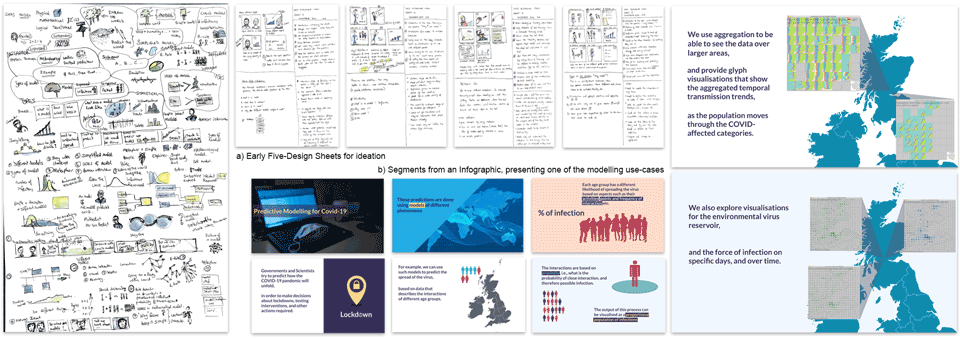RAMP VIS: Making Visual Analytics an Integral Part of the Technological Infrastructure for Combating COVID-19 - (01/2021 - 01/2022, EPSRC)

The COVID-19 pandemic has generated significant interest in data visualization, demonstrated from the media’s, and governmental and research organizations’ use of visualizations to inform the public. Within these theme, we are working on the EPSRC funded project (EP/V054236/1) RAMP VIS: Making Visual Analytics an Integral Part of the Technological Infrastructure for Combating COVID-19 (01/2020 - 12/2020).
This work is continuation of our volunteering work in the Rapid Assistance in Modelling the Pandemic (RAMP) initiative. Bangor VIS experts, along with some twenty VIS scientists, researchers, and developers in the UK answered a call in May 2020 for VIS volunteers to support modelling scientists and epidemiologists in the Scottish COVID-19 Response Consortium (SCRC), which is one of the three consortia in the Royal Society’s RAMP) programme.
The Bangor team is involved in efforts of public engagement through visualisation, and creating interfaces suitable for informing the public of the outputs of the modelling stages, as well as more general data-driven guidance on COVID-19.
Related Publications
F. McGee, M. Abu Sin, M. Chen, D. Ebert, K. Misue, P. D. Ritsos, and A. Wulff, “Preparedness for visualization in the next pandemic,” IEEE Computer Graphics and Applications (To appear), 2025.
This article discusses considerations on how visualization can be best positioned to help response to future pandemics. We examine visualization, along with the corresponding and necessary enabling technologies and platforms, as a tool to facilitate a rapid and effective response to a forthcoming pandemic. We consider challenges in terms of an infrastructure supporting world-wide response, corresponding training and stakeholder engagement, integration of future technologies, and appraisal of such systems, Finally, we discuss how addressing these challenges also helps emergency response beyond infectious diseases.
[Abstract]
[Details]
[PDF]
[doi:10.1109/MCG.2025.3561619]
J. Dykes, A. Abdul-Rahman, D. Archambault, B. Bach, R. Borgo, M. Chen, J. Enright, H. Fang, E. E. Firat, E. Freeman, T. Gönen, C. Harris, R. Jianu, N. W. John, S. Khan, A. Lahiff, R. S. Laramee, L. Matthews, S. Mohr, P. H. Nguyen, A. A. M. Rahat, R. Reeve, P. D. Ritsos, J. C. Roberts, A. Slingsby, B. Swallow, T. Torsney-Weir, C. Turkay, R. Turner, F. P. Vidal, Q. Wang, J. Wood, and K. Xu, “Visualization for Epidemiological Modelling: Challenges, Solutions, Reflections & Recommendations,” Philosophical Transactions of the Royal Society A (Special issue on ’Technical challenges of modelling real-life epidemics and examples of overcoming these’) , vol. 380, no. 2233, p. 20210299, Aug. 2022.
We report on an ongoing collaboration between epidemiological modellers and visualization researchers by documenting and reflecting upon knowledge constructs - a series of ideas, approaches and methods taken from existing visualization research and practice – deployed and developed to support modelling of the COVID-19 pandemic. Structured independent commentary on these efforts is synthesized through iterative reflection to develop: evidence of the effectiveness and value of visualization in this context; open problems upon which the research communities may focus; guidance for future activity of this type; and recommendations to safeguard the achievements and promote, advance, secure and prepare for future collaborations of this kind. In describing and comparing a series of related projects that were undertaken in unprecedented conditions, our hope is that this unique report, and its rich interactive supplementary materials, will guide the scientific community in embracing visualization in its observation, analysis and modelling of data as well as in disseminating findings. Equally we hope to encourage the visualization community to engage with impactful science in addressing its emerging data challenges. If we are successful, this showcase of activity may stimulate mutually beneficial engagement between communities with complementary expertise to address problems of significance in epidemiology and beyond.
[Abstract]
[Details]
[PDF]
[Preprint]
[doi:10.1098/rsta.2021.0299]
M. Chen, A. Abdul-Rahman, D. Archambault, J. Dykes, A. Slingsby, P. D. Ritsos, T. Torsney-Weir, C. Turkay, B. Bach, R. Borgo, A. Brett, H. Fang, R. Jianu, S. Khan, R. S. Laramee, P. H. Nguyen, R. Reeve, J. C. Robert, F. Vidal, Q. Wang, J. Wood, and K. Xu, “RAMPVIS: Answering the Challenges of Building Visualisation Capabilities for Large-scale Emergency Responses,” Epidemics, vol. 39, no. 100569, Jun. 2022.
The effort for combating the COVID-19 pandemic around the world has resulted in a huge amount of data, e.g., from testing, contact tracing, modelling, treatment, vaccine trials, and more. In addition to numerous challenges in epidemiology, healthcare, biosciences, and social sciences, there has been an urgent need to develop and provide visualisation and visual analytics (VIS) capacities to support emergency responses under difficult operational conditions. In this paper, we report the experience of a group of VIS volunteers who have been working in a large research and development consortium and providing VIS support to various observational, analytical, model-developmental, and disseminative tasks. In particular, we describe our approaches to the challenges that we have encountered in requirements analysis, data acquisition, visual design, software design, system development, team organisation, and resource planning. By reflecting on our experience, we propose a set of recommendations as the first step towards a methodology for developing and providing rapid VIS capacities to support emergency responses.
[Abstract]
[Details]
[PDF]
[Preprint]
[doi:10.1016/j.epidem.2022.100569]